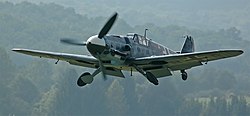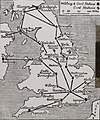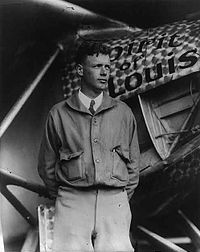| Main page | Categories & Main topics |
|
Tasks and Projects |
The Aviation Portal

Aviation includes the activities surrounding mechanical flight and the aircraft industry. Aircraft includes fixed-wing and rotary-wing types, morphable wings, wing-less lifting bodies, as well as lighter-than-air craft such as hot air balloons and airships.
Aviation began in the 18th century with the development of the hot air balloon, an apparatus capable of atmospheric displacement through buoyancy. Some of the most significant advancements in aviation technology came with the controlled gliding flying of Otto Lilienthal in 1896; then a large step in significance came with the construction of the first powered airplane by the Wright brothers in the early 1900s. Since that time, aviation has been technologically revolutionized by the introduction of the jet which permitted a major form of transport throughout the world. (Full article...)
Selected article
Selected image
Did you know
...that a Fairchild C-119 Flying Boxcar was used in the 2004 film Flight of the Phoenix? ..that Elm Farm Ollie in 1930 became the first cow to be milked while flying in an airplane? ... that Coast Aero Center and Norving were the first airlines with scheduled services at Geilo Airport, Dagali located in Hol, Norway?
General images -
In the news
- May 29: Austrian Airlines cancels Moscow-bound flight after Russia refuses a reroute outside Belarusian airspace
- August 8: Passenger flight crashes upon landing at Calicut airport in India
- June 4: Power firm helicopter strikes cables, crashes near Fairfield, California
- January 29: Former basketball player Kobe Bryant dies in helicopter crash, aged 41
- January 13: Iran admits downing Ukrainian jet, cites 'human error'
- January 10: Fire erupts in parking structure at Sola Airport, Norway
- October 27: US announces restrictions on flying to Cuba
- October 3: World War II era plane crashes in Connecticut, US, killing at least seven
- September 10: Nevada prop plane crash near Las Vegas leaves two dead, three injured
- August 6: French inventor Franky Zapata successfully crosses English Channel on jet-powered hoverboard
Related portals
Associated Wikimedia
The following Wikimedia Foundation sister projects provide more on this subject:
-
Commons
Free media repository -
Wikibooks
Free textbooks and manuals -
Wikidata
Free knowledge base -
Wikinews
Free-content news -
Wikiquote
Collection of quotations -
Wikisource
Free-content library -
Wikiversity
Free learning tools -
Wikivoyage
Free travel guide -
Wiktionary
Dictionary and thesaurus
Selected biography
He grew up in Little Falls, Minnesota. Early on he showed an interest in machinery, especially aircraft. After training as a pilot with the Army Air Service Lindbergh took a job as lead pilot of an airmail route in a DeHavilland DH-4 biplane. He was renowned for delivering the mail under any circumstances.
Lindbergh is recognized in aviation for demonstrating and charting polar air-routes, high altitude flying techniques, and increasing aircraft flying range by decreasing fuel consumption. These innovations are the basis of modern intercontinental air travel.
Selected Aircraft

The Messerschmitt Bf 109 was a German World War II fighter aircraft designed by Willy Messerschmitt in the early 1930s. It was one of the first true modern fighters of the era, including such features as an all-metal monocoque construction, a closed canopy, and retractable landing gear. The Bf 109 was produced in greater quantities than any other fighter aircraft in history, with a total of 33,984 units produced up to April 1945. Fighter production totalled 47% of all German aircraft production, and the Bf 109 accounted for 57% of all German fighter types produced.
The Bf 109 was the backbone of the Luftwaffe fighter force in World War II, although it began to be partially replaced by the Focke-Wulf Fw 190 from 1941. The Bf 109 was the most successful fighter of World War II, shooting down more aircraft than any of its contemporaries. Originally conceived as an interceptor, it was later developed to fulfill multiple tasks, serving as bomber escort, fighter bomber, day-, night- all-weather fighter, bomber destroyer, ground-attack aircraft, and as reconnaissance aircraft.
The Bf 109 was flown by the three top-scoring fighter aces of World War II: Erich Hartmann, the top scoring fighter pilot of all time with 352 victories, Gerhard Barkhorn with 301 victories, and Günther Rall with 275 victories. All of them flew with Jagdgeschwader 52, a unit which exclusively flew the Bf 109 and was credited with over 10,000 victories, chiefly on the Eastern Front. Hartmann chose to fly the Bf 109 in combat throughout the war, despite being offered the use of the Me 262. Hans-Joachim Marseille, the highest scoring German ace in the North African Campaign, also scored all of his 158 victories flying the Bf 109, against Western Allied pilots.
- Span: 9.925 m (32 ft 6 in)
- Length: 8.95 m (29 ft 7 in)
- Height: 2.60 m (8 ft 2 in)
- Engine: 1× Daimler-Benz DB 605A-1 liquid-cooled inverted V12, 1,475 PS (1,455 hp, 1,085 kW)
- Cruising Speed: 590 km/h (365 mph) at 6,000 m (19,680 ft)
- First Flight: 28 May 1935
Today in Aviation
- 2009 – Swedish airline Air Express Sweden is taken over by MCA Airlines
- 2009 – Air France Flight 447, an Airbus A330-200 flying from Rio de Janeiro, Brazil to Paris, France, crashes in the Atlantic Ocean, killing all 228 occupants, including 12 crew; bodies and aircraft debris are not recovered until several days later; the aircraft itself is not found until 2011. The crash is the first fatal accident of the A330 and the worst-ever disaster involving the A330.
- 2008 –A U.S. helicopter crashes south of Baghdad, injuring two soldiers. The type of helicopter has not been revealed.[1][2]
- 2007 – A Tanzania People’s Defence Forces passenger plane (reg JW9036) developed dual engine failure as the pilot manoeuvred to land at Dodoma airport, the pilot, Lieutenant Colonel S. M. Mayenga, said, and crash landed in the Kizota area of Dodoma. All thirteen people aboard survived.
- 2004 – America West Airlines starts service between Phoenix and Anchorage.
- 1999 – American Airlines Flight 1420, a McDonnell Douglas MD-82, skids off the runway on landing at Little Rock, Arkansas during strong winds; eleven of 145 on board die.
- 1998 – MetroJet, operated by US Airways, began operations.
- 1992 – The United States Air Force‘s Strategic Air Command is disestablished.
- 1983 – Singapore Airlines announces it has bought six Boeing 747s and four Boeing 757s, making it the first Asian airline to buy the 757.
- 1976 – Aeroflot Flight 418, a Tupolev Tu-154, crashes into a mountain side on the island of Bioko in Equatorial Guinea; all 45 on board die.
- 1975 – A Kenyan Air Force Hawker Hunter crashes at Nairobi, Kenya, during celebrations marking the anniversary of self-rule in the former British colony, the airframe impacting only a few hundred yards from where President Jomo Kenyatta is addressing a public rally. The two crew of the fighter are killed instantly, with the jet narrowly missing a crowded bus as it skids across a four-lane highway. Passengers panic as the bus brakes to a halt and fills with smoke from the burning wreckage. A second Hunter jet makes an emergency landing at Nairobi International Airport, where, according to one witness, it narrowly misses a loaded Pan American jet "by a matter of feet." The airport closes briefly after the incident.
- 1964 – The Kenyan Air Force is established
- 1961 – United Air Lines absorbs Capital Airlines to become the largest airline in the West, with a fleet of 267 aircraft.
- 1960 – Trans-Canada Air Lines begins transatlantic services, flying between Montreal and London
- 1953 – No. 423 Squadron was reformed at St. Hubert, Quebec and equipped with Avro Canada CF-100 fighters.
- 1953 – The United States Air Force Thunderbirds are activated as the 3600th Air Demonstration Team at Luke Air Force Base, Arizona on 25 May 1953, flying Republic F-84 Thunderjets.[3][better source needed]
- 1951 – British European Airways commences helicopter services between London and Birmingham
- 1950 – British European Airways commences the first regular passenger service to be flown by helicopter, between Liverpool and Cardiff.
- 1949 – A survey conducted by a firm of New York aviation consultants shows that for the first time in history air travel volume are greater than first class rail travel. Revenue passengers-miles for domestic airlines totals 603 million compared to 582 million for Pullman trains.
- 1948 – British European Airways commences the first helicopter airmail service in the UK
- 1948 – Entered Service: Convair CV-240 Convairliner with American Airlines
- 1948 – British European Airways (British European Airways) commences the first helicopter air mail service in the United Kingdom.
- 1948 – First flight of Cessna 170. The Cessna 170 is a general aviation aircraft produced by the Cessna Aircraft Company between 1948 and 1956. Over 5,000 were built, and over 2,000 are still accounted for today. The Cessna 170 landing gear is a taildragger configuration. It was replaced by the Cessna 172 which became the most popular light plane in history.
- 1944 – North West Air Command was formed at Edmonton under the command of A/V/M T. A. Lawrence.
- 1943 – Allied aircraft begin a final period of heavy bombing of Pantelleria during the ten days prior to the scheduled invasion of the island, during which they will fly 3,647 sorties.
- 1943 – In response to the Nazi dictatorship, the RCAF Second Tactical Air Force (2nd T. A. F.) was formed.
- 1943 – BOAC Flight 777, a Douglas DC-3, is shot down by Luftwaffe fighter aircraft over the Bay of Biscay, killing 17 passengers and crew, including actor Leslie Howard and leading to speculation that the flight was attacked because German intelligence believed that British Prime Minister Winston Churchill was aboard.
- 1942 – Because of the similarity of the red disc in the center of the national insignia for U. S. military aircraft USAAC to Japanese markings, the United States adopts a new national insignia without the red disc, consisting simply of a white star centered in a blue circle USAAC roundel.The new marking will remain in use until July 1943.
- 1942 – (Overnight) – Royal Air Force Bomber Command mounts what is nominally its second “thousand-bomber raid” – 956 bombers actually participate – Targeting Essen, Germany. Industrial haze spoils the attack; the British bombers kill only 15 people in Essen and destroy only 11 homes there, while widely scattered bombs strike Oberhausen, Duisburg, and at least eleven other cities and towns, which suffer more damage than Essen itself.
- 1941 – Germany completes the conquest of Crete. German airborne forces have suffered such heavy losses – probably 6,000 to 7,000 casualties and 284 aircraft lost – In the eleven days of fighting that Germany never again attempts a large airborne operation.
- 1941 – German Junkers Ju 88 bombers sink the British light cruiser HMS Calcutta 100 nautical miles (185 km) north of Alexandria, Egypt, as she retires after evacuating troops from Crete.
- 1940 – U. S. Army Air Corps announces plans for the construction of the world’s most powerful wind tunnel at Wright Field, Dayton, Ohio.
- 1939 – First flight of the Focke-Wulf Fw 190
- 1939 – The Douglas DC-4 makes its first passenger flight from Chicago to New York.
- 1927 – Western Canada Airways inaugurated weekly air service from Winnipeg to Long Lake, Manitoba via Lac du Bonnet.
- 1925 – A car dealer covers himself in stamps worth $718 in a bid to be sent airmail from San Francisco to New York; the U. S. Post Office refuses to accept him.
- 1919 – A permanent flight of aircraft is stationed in San Diego to serve as a forest fire patrol. The machines are war-surplus Curtiss JN-4s.
- 1915 – The United States Department of the Navy awards its first contract for an airship – The DN-1-Class Blimp – To the Connecticut Aircraft Company.
- 1915 – Germany conducts the first zeppelin air raid over England.
- 1912 – The first military aeroplane flight in Norway is made by Lt Hans Dons in HNoMS Start an Etrich Taube(pictured).
References
- ^ Ross Colvin (2008-06-01). "Two US soldiers injured in Iraq helicopter crash". Reuters. Retrieved 2008-06-01.
- ^ "US helicopter crashes in Iraq; 2 soldiers injured". The Associated Press. 2008-06-01. Retrieved 2008-06-01.
- ^ United States Air Force Thunderbirds
- Shortcuts to this page: Portal:Airplanes • P:AVIA




















































